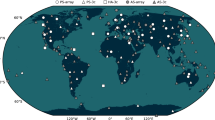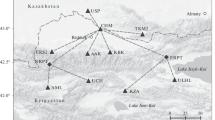Abstract
The site characterisation of future underground gravitational wave detectors is based on spectral properties of the low frequency seismic noise. The evaluation of the collected long term seismological data in the Mátra Gravitational and Geophysical Laboratory revealed some aspects that are not apparent in short term spectral noise characterisation. In this paper we survey the methodology. In particular, we argue that the spectral properties are best represented by percentiles of the data instead of the mode, because it is noisy, sensitive to the discretization and intrinsic averaging, therefore it is less suitable for a robust characterisation. The suitable cumulative measures are also scrutinized.






Similar content being viewed by others
Notes
Global strategies for gravitational wave astronomy. Report from the Dawn IV workshop; Amsterdam August 30, 31 2018. https://dcc.ligo.org/public/0158/P1900028/004. April 22, 2019.
Black Forest line is originally approximates from below the 10th percentiles of the acceleration PSD of the Black Forest site (ET Science Team 2011).
See the manual of the instrument. http://www.guralp.com/documents/DAS-030-0120.pdf.
Other instruments, the Trillium seismometer in Beker et al. (2015), work with 128 Hz sampling rate. Then the 128 s interval is convenient for fast Fourier calculation, but hourly or daily spectra require truncations.
Beker originally defined \(sigma\_{ET}\) also to distinguish the distributions of PSDs. In this paper we do not want to explore this quantity but focus only to the rms.
The planned detection length of GW signals could reach 1–10000 s. It could be reasonable to use a more suitable—less than the order of expected detection length—than the \(14\times 128\,\mathrm{{s}}\) averaging of Beker et al. (2015). Furthermore the STA makes the overlapping much easier to handle.
References
Abbott BP, Abbott R, Abbott TD, Abernathy MR, Acernese F, Ackley K, Adams C, Adams T, Addesso P, Adhikari RX et al (2016) Observation of gravitational waves from a binary black hole merger. Phys Rev Lett 116(6):061102
Barnaföldi GG, Bulik T, Cieslar M, Dávid E, Dobróka M, Fenyvesi E, Gráczer Z, Hamar G, Huba G, Kis Á, Kovács R, Lemperger I, Lévai P, Molnár J, Nagy D, Novák A, Oláh L, Pázmándi P, Piri D, Rosinska D, Somlai L, Starecki T, Suchenek M, Surányi G, Szalai S, Varga D, Vasúth M, Ván P, Vásárhelyi B, Wesztergom V, Wéber Z (2017) First report of long term measurements of the MGGL laboratory in the Mátra mountain range. Class Quantum Gravity 34(22):114001. arXiv: 1610.07630
Beker MG (2013) Low-frequency sensitivity of next generation gravitational wave detectors. Ph.D. thesis, Vrije Universiteit Amsterdam, Amsterdam
Beker MG, van den Brand JFJ, Rabeling DS (2015) Subterranean ground motion studies for the Einstein telescope. Class Quantum Gravity 32(2):025002
ET Science Team (2011) Einstein gravitational wave Telescope, Conceptual Design Study. Technical Report ET-0106C-10. http://www.et-gw.eu/etdsdocument
Fiorucci D, Harms J, Barsuglia M, Fiori I, Paoletti F (2018) Impact of infrasound atmospheric noise on gravity detectors used for astrophysical and geophysical applications. Phys Rev D 97(6):062003
Harms J (2015) Terrestrial gravity fluctuations. Living Rev Relativ 18(1):3
Peterson J (1993) Observations and modeling of seismic background noise. Open-File Report, USGS, RN:93-322
van den Brand JFJ, Beker MG, Doets M, Hennes E, Rabeling DS (2010) Einstein telescope site selection: seismic and gravity gradient noise. J Phy: Conf Ser 203:012076
Ván P, et al. Long term measurements from Matra Gravitational and Geophysical Laboratory, under publication
Acknowledgements
The work was supported by the Grants National Research, Development and Innovation Office—NKFIH 116197(116375) NKFIH 124366(124508) and NKFIH 123815. The support of the PHAROS (CA16214) and G2net (CA17137) COST Actions is also acknowledged. The authors thank Géza Huba for the constant support and help, for Zoltán Zimborás and Jan Harms for important remarks. Also the help and support of the Nitrokémia Zrt and GEO-FABER Zrt. is greatly acknowledged.
Author information
Authors and Affiliations
Corresponding author
Rights and permissions
About this article
Cite this article
Somlai, L.Á., Gráczer, Z., Lévai, P. et al. Seismic noise measures for underground gravitational wave detectors. Acta Geod Geophys 54, 301–313 (2019). https://doi.org/10.1007/s40328-019-00257-5
Received:
Accepted:
Published:
Issue Date:
DOI: https://doi.org/10.1007/s40328-019-00257-5




